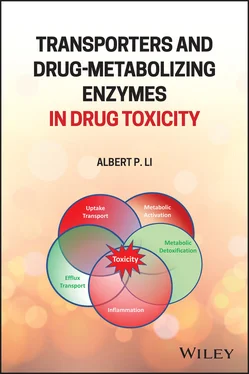Cerivastatin is one of the drugs where toxicity can be a function of both drug metabolism and transport. Besides being a CYP2C8 inhibitor, Gemfibrozil and its glucuronide are inhibitors of cerivastatin uptake by the organic anion transporting polypeptide 2 (OATP2/OATP1B1:SLC21A6) [58, 63]. Inhibition of transporter‐mediated uptake of cerivastatin into hepatocytes leads to lower hepatic metabolic clearance. Physiologically based pharmacokinetic (PBPK) models have been developed to evaluate the complex interaction between cerivastatin and gemfibrozil, taking into account the inhibitory effects of gemfibrozil on cerivastatin uptake and metabolism [64, 65].
The toxicity of cerivastatin is a function of plasma drug concentration which is determined by hepatic uptake and metabolism. Environmental and genetic conditions leading to reduction of hepatic CYP2C8 and OATP transporter activities are likely to be risk factors for cerivastatin‐induced rhabdomyolysis. Co‐exposure to CYP2C8 inhibitor as a major key factor has already been demonstrated with the high incidence of rhabdomyolysis in patients coadministered gemfibrozil. Genome wide association evaluation of 185 rhabdomyolysis patients in a case control study has identified genetic variants of OATP1B1(SLCO1B1), a nonsynonymous coding variant rs4149056 variant, as a statistically significant risk factor for patients administered cerivastatin without gemfibrozil coadministration [61]. Transfection of the variant gene into an in vitro cell culture system shows reduced cerivastatin uptake when compared to wild type, strongly suggesting that patients with the variant OATP1B1 had a similar reduction in cerivastatin uptake. In the same study, no association of CYP2C8 variants with rhabdomyolysis was observed. The results appear to suggest that uptake transporter may be a more important risk factor for rhabdomyolysis for patients administered with cerivastatin alone.
Felbamate is an anticonvulsant with a dual mechanism of action both as an agonist of gamma‐aminobutyric acid (GABA) receptors and also an antagonist of N ‐methyl‐D‐aspartate receptor (NMDA) receptors [66]. It was approved by FDA in August 1993 for the treatment of seizures associated with Lennox–Gastaut syndrome in children, but was withdrawn within a year in August 1994 due to its association with aplastic anemia [67]. Felbamate was provided a redemption in September 1994 for limited use in patients with refractory epilepsy [68], and with additional warning due to its association with rare incidence of acute liver failure, including cases with fatalities [67,69–71].
3.4.1 Drug Metabolism and Toxicity
Association of felbamate administration and aplastic anemia was the key reason for the initial market withdrawal of felbamate [72]. Upon its redemption, felbamate was also known to be associated with idiosyncratic acute liver failures [73].
The mechanism for felbamate toxicity is not yet fully defined. While aplastic anemia was the initial reason for the market withdrawal of felbamate, most research activities were focused on its hepatotoxicity. Felbamate has been reported to be subjected to P450‐mediated oxidation, with CYP3A4 and CYP2E1 identified to be the major isoforms involved in its metabolism [74], an observation that was made in vitro but was not confirmed in clinical studies with CYP3A4 inhibitors [75]. The reported reactive metabolites generated upon hepatic metabolism include alpha, beta‐unsaturated aldehyde, atropaldehyde (ATPAL) [76, 77], and 2‐phenylpropenal (a metabolite formed by hydrolysis of felbamate to 2‐phenyl‐1,3‐propandiol monocarbamate [MCF], followed by oxidation to 3‐carbamoyl‐2‐phenylpropionaldehyde [CBMA], and spontaneous loss of carbon dioxide and ammonia) [78–80]. An ongoing hypothesis is the oxidative stress and conjugation of macromolecules by reactive metabolites of felbamate, leading to the onset of a cascade of events which ultimately result in acute liver failure [81]. It is interesting to note that felbamate is an inhibitor of CYP2C19 [75] and a heteroactivator (not inducer) of CYP3A4 [74].
3.4.2 Transporters and Toxicity
Treatment of rats with verapamil, a Pgp inhibitor, was found to increase felbamate brain accumulation, suggesting that felbamate is a substrate for the efflux transporter [82]. However, no difference in felbamate distribution in the central nervous system was observed between wild type and multidrug resistance‐associated protein 2 (MRP2)‐deficient rats [83], suggesting that felbamate is not a substrate for this transporter. There are no reports on transporters for felbamate uptake.
Based on current knowledge, genetic and environmental factors that would enhance the formation of reactive metabolites (CYP3A4 induction), reduction of detoxification (GSH depletion), and increased intracellular accumulation (Pgp inhibition) are potential risk factors for felbamate hepatotoxicity.
Flucloxacillin, an isoxazolyl penicillin, is a narrow spectrum antibiotic of the penicillin class that has a broad range of uses in the treatment of Gram‐positive bacterial infections of skin and soft tissue [84, 85], lung [86], urinary tract [87], meningitis [88, 89] and is used as a prophylaxis during surgery [90–92]. Flucloxacillin treatment has been associated with severe hepatotoxicity, resulting in liver failure [93, 94]. A genome wide association study (GWAS) showed an association of flucloxacillin‐induced liver toxicity with the HLA‐B*5701 genotype [95–97].
3.5.1 Drug Metabolism and Toxicity
Flucloxacillin has been shown to be metabolized primarily by CYP3A4, CYP3A7, and CYP2C9 in hepatocytes to 5‐hydroxymethyl flucloxacillin [98, 99], a metabolite cytotoxic to biliary epithelial cells, resulting in hepatotoxicity [99–101]. Flucloxacillin has been shown to be an inducer of CYP3A4 both in vitro in hepatocytes, and in clinical studies [102], suggesting that prolonged treatment of patients may lead to increased CYP3A4 induction, resulting in a higher rate of formation of the cytotoxic metabolite. Plasma from patients exposed to flucloxacillin has been found to contain human serum albumin with modified lysine residues as a result of the covalent binding with 5‐hydroxymethyl flucloxacillin, leading to the hypothesis that immune reaction to the neoantigens may be one of the key mechanism of hepatotoxicity [103].
3.5.2 Transporters and Toxicity
The membrane transporter MRP2 has been found to mediate the binding of flucloxacillin proteins localized in bile canaliculi regions [104] which has been hypothesized to be one of the determinants of its hepatotoxicity.
The association of flucloxacillin‐induced liver toxicity with the HLA‐B*5701 genotype [95–97] represents the most successful application of GWAS in the identification of an at‐risk population based on genotype. Unfortunately, the association cannot be extended to other DILI drugs. Based on the metabolism of flucloxacillin to the cytotoxic metabolite 5‐hydroxymethyl flucloxacillin, patient populations with enhanced CYP3A4, CYP3A7, and CYP2C9 activities due to environmental and genetic factors, may be at risk of its hepatotoxicity. The findings with MRP2‐mediation of the localization of flucloxacillin in biliary cells suggest that increased MRP2 activity may also be a risk factor.
Nefazodone is a phenylpiperazine antidepressant which received approval from the Food and Drug Administration for treatment of major depressive disorder in 1994. Nefazodone enhances serotonin (5‐hydroxytryptamine [5‐HT]) synaptic transmission by acting as a potent antagonist of 5‐HT2 receptors and as a 5‐HT uptake inhibitor (SARI) as well as a weak serotonin‐norepinephrine‐dopamine uptake inhibitor (SNDRI) [105–109]. Nefazodone is efficacious toward the treatment of depression with depression‐related anxiety symptoms [106]. Nefazodone administration has been found to be associated with the occurrence of idiosyncratic liver failure resulting in deaths and a need for liver transplantation [110–115]. Nefazodone was withdrawn from the US market in 2004 [116, 117]. A survey of Canadian patients shows that a majority of the patients with nefazodone‐induced liver injuries occurred within eight months of administration [118].
Читать дальше












